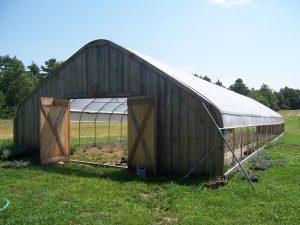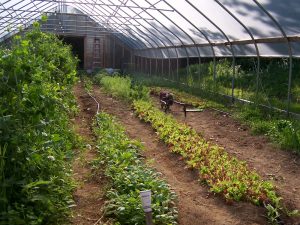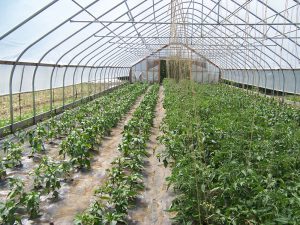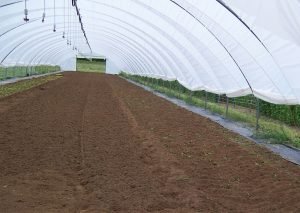Bulletin #1026, Adding a High Tunnel to Your Maine Farm: Observations from a Statewide Study
Developed by Caragh Fitzgerald, Extension Educator, and Mark Hutton, Extension Specialist, University of Maine
For information about UMaine Extension programs and resources, visit extension.umaine.edu.
Find more of our publications and books at extension.umaine.edu/publications/.
In 2011, we visited 31 Maine farmers to talk about their high tunnel production practices, benefits, and challenges. Some farmers in the study were new to growing crops in high tunnels, while others were experienced tunnel producers. In all, we collected data on 52 high tunnels. Below are some results and observations from this study that can help farmers effectively plan for and use high tunnels to increase profitability. More complete results can be found in our article “Production Practices and Challenges with High Tunnel Systems in Maine,” published in the Journal of the NACAA.
Table of Contents
- Tunnel style
- Site selection
- Crops
- Irrigation
- Soil testing
- Nutrient sources
- Pests and diseases
- Time and comfort
- Harvest period and yield
- Overall satisfaction
- Other considerations
- Acknowledgments
Tunnel style
In this study, 87% of the tunnels were Gothic-style (peaked roof). This style of house can more easily withstand Maine winter snow loads than can Quonset-style houses. Some of the Quonset-style houses in the study were used only for spring-summer-fall production and so were not covered year-round.
Site selection
Drainage
It is best to choose the site for a high tunnel carefully and address any drainage problems before beginning construction. The soil must have good drainage, and water should be diverted away from the tunnel.
Farmers specifically addressed drainage problems before construction of 23% of the tunnels in our study. Farmers reported drainage problems after the construction of 16% of tunnels (including one that underwent pre-construction drainage work).
Proximity and space
When choosing a site, consider ease of access. High tunnels require attention at least twice a day in the spring and fall. This is easier if they are located near the farm’s headquarters.
Leave room for expansion, too. Many farmers are so pleased with their first tunnel that they add a second one. It is easier to manage the tunnels if they are located together.
Crops
We looked at summer cropping patterns in 31 tunnels. Tomatoes were the most common crop, being grown in 84% of the tunnels. Greens (55%), cucumbers (35%), and peppers (29%) were also common. Some farmers were able to grow certain crops in the tunnels that could not be successfully grown in the field, such as colored peppers or certain types of cut flowers. Most farmers did not have a market for winter crops and did not use their tunnels to grow them.
While the majority of tunnels were used to grow only one or two crop types in the summer, 45% had three or more crop types. Smaller farms tended to have more types of crops growing at a time than larger farms. Keep in mind that the different growing requirements of multiple crops can complicate temperature, irrigation, and pest management.
Irrigation
Since rainwater doesn’t get into a high tunnel, supplemental irrigation is needed. Many farmers, including the majority of those in this study, do not use trickle irrigation in the field. However, our study showed that most farmers (61%) use trickle irrigation in their tunnels. We suggest that you learn how to operate this or any irrigation system before tunnel construction if possible. If not, budget extra time after construction to learn and manage the system.
Check your water quality and supply to be sure it is adequate. Some farmers in our study did not have sufficient water and had to choose between watering tunnel crops and watering field crops or livestock. Applying mulch in and between the crop rows can help conserve soil moisture. Plastic and landscape fabric were the most commonly used mulches in our study.
Soil testing
Take soil tests yearly and plan amendments accordingly. For the first few years after a tunnel is constructed, standard soil tests should be adequate, with the addition of specific tests for soluble salts as well as nitrate. After three years of production on a site, consider using the saturated media extract method to monitor soil nutrient levels. This test extracts nutrients in a different way than standard methods, and it is currently thought to provide better data for making nutrient recommendations. All of these tests can be run by the Analytical Lab and Maine Soil Testing Service for a small fee. Information, soil boxes, and forms can be obtained from the lab or from your county University of Maine Cooperative Extension office.
Our study showed some tunnels with low pH levels, indicating that farmers could have improved production by monitoring their soil nutrient status and amending soil appropriately.
While our study did not show many tunnels with elevated salt levels, this is a concern with long-term tunnel production. Without typical rain and snowfall to leach out salts, they are prone to accumulating in high tunnel soils. Monitor salt levels with annual testing.
Nutrient sources
Nearly all farmers in this study used manure or compost as a source of nutrients in their high tunnels. High organic matter levels in some tunnels indicated application rates that were higher than necessary for soil quality benefits. Excess compost applications can represent unnecessary cost and labor for the farm, may increase salt levels and can change water dynamics in the soil.
To minimize food safety risks, wait 180 days between the application of raw or uncomposted manure and crop harvest. If you can’t confirm that the compost you are using is well-composted (reaching the adequate temperature for a given period), manage it as if it is uncomposted.
Pests and diseases
Most farmers reported insect pressure in the tunnels to be similar to insect pressure in the same crops outside the tunnels. Often the types of insects were different, though. Most farmers reported lower disease pressure inside their tunnels. This is probably because the foliage stays drier in the tunnel.
Time and comfort
Most farmers reported that managing crops in the high tunnel took more time than managing the same crops in the field. They also noted that some activities, such as grading and washing, took less time. A high tunnel can provide a comfortable place to work in bad weather.
Harvest period and yield
One primary reason farmers use high tunnels is to extend the growing and harvest season. The farmers in this study reported marketable harvest dates for tomatoes, peppers, and cucumbers that were up to a month earlier and a month later compared to these crops in the field. A farmer with an early product when supply is low can often get a higher price than later in the season. Although data were limited, farmers reported higher yields and/or gross income for high tunnel tomatoes, peppers, cucumbers, and greens.
Overall satisfaction
Most farmers in this study reported that having a high tunnel had met their expectations. Most were planning to add or considering adding another high tunnel or protected structure in the future.
Other considerations
Remember that there are other types of season extension—plastic mulches, succession planting, low tunnels—that might meet the farm’s needs at less expense. See Bulletin #1022, Maine Season Extension Options: Making the Right Choice for Your Farm for a summary of these options.
Also, be sure to evaluate your market and how a tunnel will fit in. Will you get paid more for having an early product? Are you interested in the increased quality? Are there specific crops you want to grow in the high tunnel that you can’t grow in the field? If these benefits are significant, they are all great reasons to add a high tunnel to your business.
Acknowledgments
This material is based upon work supported by the Natural Resources Conservation Service, U.S. Department of Agriculture, under NRCS Agreement Number 69-1218-0-28. Any opinions, findings, conclusions, or recommendations expressed in this publication are those of the authors and do not necessarily reflect the view of the U.S. Department of Agriculture.
We would like to thank Justine Rushing for her assistance with data collection.
Reviewed by David Handley, Extension Specialist, University of Maine.
Information in this publication is provided purely for educational purposes. No responsibility is assumed for any problems associated with the use of products or services mentioned. No endorsement of products or companies is intended, nor is criticism of unnamed products or companies implied.
© 2013
Call 800.287.0274 (in Maine), or 207.581.3188, for information on publications and program offerings from University of Maine Cooperative Extension, or visit extension.umaine.edu.
In complying with the letter and spirit of applicable laws and pursuing its own goals of diversity, the University of Maine System does not discriminate on the grounds of race, color, religion, sex, sexual orientation, transgender status, gender, gender identity or expression, ethnicity, national origin, citizenship status, familial status, ancestry, age, disability physical or mental, genetic information, or veterans or military status in employment, education, and all other programs and activities. The University provides reasonable accommodations to qualified individuals with disabilities upon request. The following person has been designated to handle inquiries regarding non-discrimination policies: Director of Institutional Equity and Title IX Services, 5713 Chadbourne Hall, Room 412, University of Maine, Orono, ME 04469-5713, 207.581.1226, TTY 711 (Maine Relay System).





